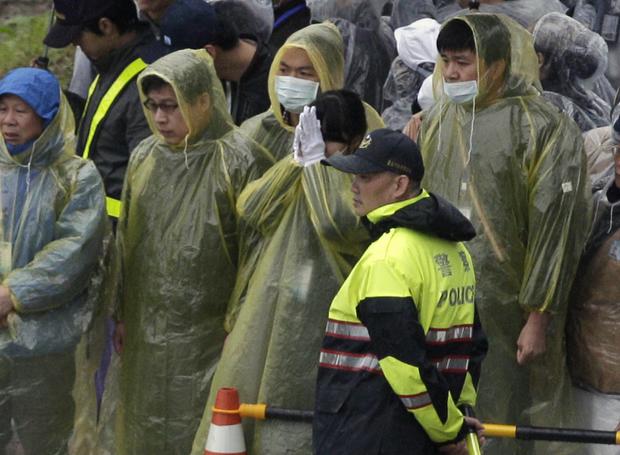TransAsia pilots found still clutching controls
TAIPEI, Taiwan -- Divers pulled four bodies Friday from the river where a TransAsia Airways propjet crashed shortly after takeoff from Taiwan's capital, raising the death toll to 35 while relatives gathered on the riverbank wailed in anguish.
As the victims remains were recovered, officials in Taipei said flight data from the downed aircraft showed both engines had lost power before the jet crashed into a river.
Helicopters helped scan the river for eight people still missing. Fifteen survived with injuries in the crash Wednesday, moments after the pilots reported engine trouble.
Taiwan's Vice President Wu Den-yih, mindful of the island's reputation as a tourist destination and its tense relations with China where most of the flight's passengers were from, went to a Taipei funeral parlor for a prayer session to pay respects.
At the parlor, where bodies are being stored and which drew a trickle of victims' relatives, Wu expressed condolences and praised the pilot Liao Chien-chung, who died in the crash. The pilots may have deliberately steered the plane away from buildings and into the river in the final moments.
"When it came to when it was clear his life would end, (the pilot) meticulously grasped the flight operating system and in the final moments he still wanted to control the plane to avoid harming residents in the housing communities," Wu said.
"To the plane's crew, the victims... I here express condolences."
Divers with a local fire agency found one female and three male bodies before noon in poor underwater visibility along the muddy Keelung River bottom about 50 meters from the crash site, a Taipei City Fire Department official surnamed Chen said.
The agency suspects the eight missing bodies may be in equally murky spots and has sent 190 divers to look for them. Taiwan's Ministry of National Defense dispatched three S-70C rescue helicopters to search along a Taipei river system that runs into the ocean off Taiwan's northwest coast.
More than 30 relatives of victims cried wildly, prayed or were comforted by Buddhist volunteers at the riverside crash site as divers in black wet suits brought back the four bodies. Some divers came ashore with hands crossed to pray for the people they brought back.
The pilot's and co-pilot's bodies were found earlier with joysticks still in their hands, Taiwan's ETToday online news service said.
Shortly after the doomed flight's takeoff before 11 a.m. Wednesday, one of the pilots issued a "Mayday, mayday, engine flameout" distress call. Flameout normally indicates that flames have been extinguished in the combustion chamber of the engine, shutting it down and not driving the propeller.
Video images of Flight GE235's final moments in the air captured on car dashboard cameras show the left engine's propeller at standstill as the aircraft turned sharply, its wings going vertical and clipping a highway bridge before plunging into the river.
Taiwan's Aviation Safety Council has started investigating causes for the crash, a process likely to take up to a year but with few obstacles expected.
"Our process usually takes about one year or a year and a half, faster than in other countries," said an Aviation Safety Council official who declined to be named. "According to our procedure, I don't expect anything to special about this investigation."
TransAsia Airways declined comment on which engine may have flamed out, noting only that the "number one" engine had been replaced in April when the ATR-72 aircraft was new. The aviation safety official also declined to speculate.
The same airline had operated another ATR-72 propjet that crashed in an outlying Taiwan-controlled island on July 23, killing 48.
Taiwan President Ma Ying-jeou's office said Thursday it was worried that air crashes would soil the island's reputation as a tourism destination.
Thirty-one of the flight's passengers were from China, whose tourists to Taiwan rose from a trickle before mid-2008 to a total 9.7 million as of last year.
China has claimed sovereignty over Taiwan since the Chinese civil war of the 1940s, chilling relations until Ma took office in 2008 and opened dialogue that led to an agreement allowing tourist visits. Tourists from China have also died under falling rocks and at a construction site accident. A bus crash three years ago in eastern Taiwan injured 34. There were 31 passengers from China on the plane that crashed Wednesday.
The vice president's appearance at the funeral home may be a "gestures to keep up benign relations," said Alexander Huang, strategic studies professor at Tamkang University in Taiwan.
As both sides handle the crash aftermath, a Chinese government minister in charge of Taiwan affairs postponed a visit scheduled for Saturday and Sunday.
The two sides also need more time to discuss four new domestic flight routes that China declared on its own last month, Taiwan's China policymaking body said in a statement. Taiwan opposes the new Taiwan Strait air routes, saying they could cause safety problems for its own domestic flights.
